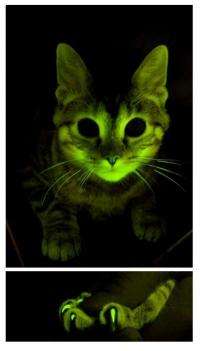Glowing cats help in fight against AIDS, other diseases

Mayo Clinic researchers have developed a genome-based immunization strategy to fight feline AIDS and illuminate ways to combat human HIV/AIDS and other diseases. The goal is to create cats with intrinsic immunity to the feline AIDS virus. The findings -- called fascinating and landmark by one reviewer -- appear in the current online issue of Nature Methods.
Feline immunodeficiency virus (FIV) causes AIDS in cats as the human immunodeficiency virus (HIV) does in people: by depleting the body's infection-fighting T-cells. The feline and human versions of key proteins that potently defend mammals against virus invasion -- termed restriction factors -- are ineffective against FIV and HIV respectively. The Mayo team of physicians, virologists, veterinarians and gene therapy researchers, along with collaborators in Japan, sought to mimic the way evolution normally gives rise over vast time spans to protective protein versions. They devised a way to insert effective monkey versions of them into the cat genome.
"One of the best things about this biomedical research is that it is aimed at benefiting both human and feline health," says Eric Poeschla, M.D., Mayo molecular biologist and leader of the international study. "It can help cats as much as people."
Dr. Poeschla treats patients with HIV and researches how the virus replicates. HIV/AIDS has killed over 30 million people and left countless children orphaned, with no effective vaccine on the horizon. Less well known is that millions of cats also suffer and die from FIV/AIDS each year. Since the project concerns ways introduced genes can protect species against viruses, the knowledge and technology it produces might eventually assist conservation of wild feline species, all 36 of which are endangered.
The technique is called gamete-targeted lentiviral transgenesis -- essentially, inserting genes into feline oocytes (eggs) before sperm fertilization. Succeeding with it for the first time in a carnivore, the team inserted a gene for a rhesus macaque restriction factor known to block cell infection by FIV, as well as a jellyfish gene for tracking purposes. The latter makes the offspring cats glow green.
The macaque restriction factor, TRIMCyp, blocks FIV by attacking and disabling the virus's outer shield as it tries to invade a cell. The researchers know that works well in a culture dish and want to determine how it will work in vivo. This specific transgenesis (genome modification) approach will not be used directly for treating people with HIV or cats with FIV, but it will help medical and veterinary researchers understand how restriction factors can be used to advance gene therapy for AIDS caused by either virus.
The method for inserting genes into the feline genome is highly efficient, so that virtually all offspring have the genes. And the defense proteins are made throughout the cat's body. The cats with the protective genes are thriving and have produced kittens whose cells make the proteins, thus proving that the inserted genes remain active in successive generations.
More information: www.nature.com/nmeth/index.html















